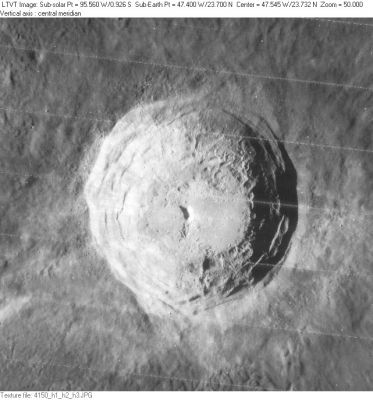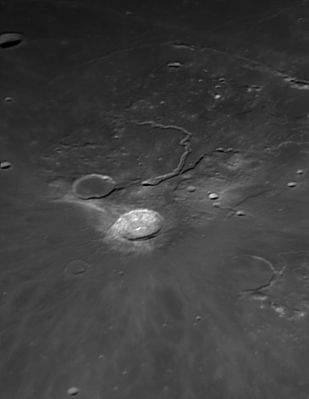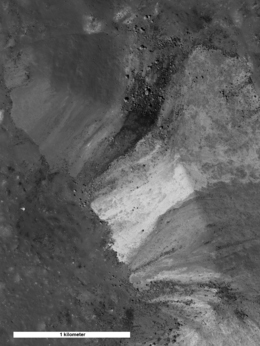Difference between revisions of "Aristarchus"
| Line 5: | Line 5: | ||
Lat: 23.7°N, Long: 47.4°W, Diam: 40 km, Depth: 3.15 km, [[R%C3%BCkl%2018|Rükl: 18]], [[Stratigraphy|Copernican]]<br /> | Lat: 23.7°N, Long: 47.4°W, Diam: 40 km, Depth: 3.15 km, [[R%C3%BCkl%2018|Rükl: 18]], [[Stratigraphy|Copernican]]<br /> | ||
|} | |} | ||
| − | [http://www.lpod.org/coppermine/displayimage.php?pid=3012&fullsize=1 [[Image: | + | [http://www.lpod.org/coppermine/displayimage.php?pid=3012&fullsize=1 [[Image:Normal_Aristarchus_LO-IV-150H_LTVT.JPG|external image normal_Aristarchus_LO-IV-150H_LTVT.JPG]]][http://www.lpod.org/coppermine/displayimage.php?pid=81&fullsize=1 [[Image:Normal_shroteredone.jpg|external image normal_shroteredone.jpg]]]<br /> '''Left''': ''[http://lpod.org/coppermine/displayimage.php?pos=-3012 LO-IV-150H]'' '''Aristarchus''' viewed from overhead (north up). '''Middle''': ''[http://lpod.org/coppermine/displayimage.php?pos=-81 Mike Wirths]'' '''Aristarchus''' as seen from Earth, with [[Herodotus|Herodotus]] and [[Schr%C3%B6ter%27s%20Valley|Schröter's Valley]] beyond, and [[Prinz|Prinz]] and the [[Montes%20Harbinger|Harbinger Mountains]] in the right foreground (north is to the upper right).<br /> <br /> <div id="toc"> |
==Images== | ==Images== | ||
| Line 15: | Line 15: | ||
* [http://lroc.sese.asu.edu/news/?archives/257-Up-from-the-depths.html Central peak] view in LROC [http://wms.lroc.asu.edu/lroc_browse/view/M122523410LE NAC M122523410]{| class="captionBox" | * [http://lroc.sese.asu.edu/news/?archives/257-Up-from-the-depths.html Central peak] view in LROC [http://wms.lroc.asu.edu/lroc_browse/view/M122523410LE NAC M122523410]{| class="captionBox" | ||
| class="captionedImage" | | | class="captionedImage" | | ||
| − | [http://lroc.sese.asu.edu/news/uploads/arist_cpeak_2.5mp.png [[Image: | + | [http://lroc.sese.asu.edu/news/uploads/arist_cpeak_2.5mp.png [[Image:Aristarchus-peak.jpg|aristarchus-peak.jpg]]] |
|- | |- | ||
| class="imageCaption" | Close-up of central peak from LROC's NAC M122523410 | | class="imageCaption" | Close-up of central peak from LROC's NAC M122523410 | ||
| Line 25: | Line 25: | ||
<br /> | <br /> | ||
==Description: Elger== | ==Description: Elger== | ||
| − | ''([[IAU% | + | ''([[IAU%20directions|IAU Directions]])'' ARISTARCHUS.--The brightest object on the moon, forming with [[Herodotus|Herodotus]] (a companion ring-plain on the W.), and its remarkable surroundings, one of the most striking objects which the telescope has revealed on the visible surface, and one requiring much patient observation before its manifold details can be fully noted and duly appreciated. Its border rises 2,000 feet above the outer surface on the E., but towers to more than double this height above the glistening floor. No lunar object of its moderate dimensions (it is only about 29 miles in diameter) has such conspicuously terraced walls, or a greater number of spurs and buttresses; which are especially prominent on the S. A valley runs round the outer slope of the E. wall, very similar to that found in a similar position round [[Marius|Marius]]. There is also a distinct valley on the brilliant inner slope of the W. wall, below its crest. It originates at a bright little crater, and is traceable round the greater portion of the declivity. Under a moderately high sun, an oval area, nearly as large and fully as brilliant as the central mountain, is seen on this inner slope. It is bordered on either side by bands of a duskier hue, which probably represent shallow transverse valleys. From its dazzling brilliancy it is very difficult to observe the interior satisfactorily. In addition, however, to the central mountain, there is a crater on the N.E. side of the floor. On the S. side of Aristarchus is a large dusky ring some 10 miles in diameter, connected by ridges with the spurs from the wall, and on the S.W., close to the foot of the slope, is another smaller ring of a like kind.<br /> <br /> |
==Description: Wikipedia== | ==Description: Wikipedia== | ||
[http://en.wikipedia.org/wiki/Aristarchus_(crater) Aristarchus]<br /> <br /> | [http://en.wikipedia.org/wiki/Aristarchus_(crater) Aristarchus]<br /> <br /> | ||
==Additional Information== | ==Additional Information== | ||
| − | * Depth data from [[Kurt%20Fisher% | + | * Depth data from [[Kurt%20Fisher%20Crater%20Depths|Kurt Fisher database]] |
** Pike, 1976: 3.15 km | ** Pike, 1976: 3.15 km | ||
** Westfall, 2000: 3.15 km | ** Westfall, 2000: 3.15 km | ||
| Line 36: | Line 36: | ||
** Cherrington, 1969: 3.62 km | ** Cherrington, 1969: 3.62 km | ||
* Central peak height | * Central peak height | ||
| − | ** [[Sekiguchi%2C%201972|Sekiguchi, 1972]]: <0.2 "A very low central mound" <span class="membersnap">- [http://www.wikispaces.com/user/view/fatastronomer [[Image: | + | ** [[Sekiguchi%2C%201972|Sekiguchi, 1972]]: <0.2 "A very low central mound" <span class="membersnap">- [http://www.wikispaces.com/user/view/fatastronomer [[Image:Fatastronomer-lg.jpg|16px|fatastronomer]]] [http://www.wikispaces.com/user/view/fatastronomer fatastronomer]</span> |
* [[Central%20peak%20composition|Central peak composition]]: GNTA1 & GNTA2 ([[Tompkins%20%26%20Pieters%2C%201999|Tompkins & Pieters, 1999]]) | * [[Central%20peak%20composition|Central peak composition]]: GNTA1 & GNTA2 ([[Tompkins%20%26%20Pieters%2C%201999|Tompkins & Pieters, 1999]]) | ||
* Included in [[ALPO%20list%20of%20bright%20ray%20craters|ALPO list of bright ray craters]]. | * Included in [[ALPO%20list%20of%20bright%20ray%20craters|ALPO list of bright ray craters]]. | ||
Revision as of 18:44, 15 April 2018
Contents
Aristarchus
|
Lat: 23.7°N, Long: 47.4°W, Diam: 40 km, Depth: 3.15 km, Rükl: 18, Copernican |


Left: LO-IV-150H Aristarchus viewed from overhead (north up). Middle: Mike Wirths Aristarchus as seen from Earth, with Herodotus and Schröter's Valley beyond, and Prinz and the Harbinger Mountains in the right foreground (north is to the upper right).
Images
LPOD Photo Gallery Lunar Orbiter Images Apollo Images
- Close-ups of Aristarchus made by Lunar Orbiter 5: frames 5194 to 5200. Research Danny Caes.
- AS15-88-12005 is one of Apollo 15's orbital Hasselblads of the Aristarchus'/ Herodotus/ Vallis Schröteri region. The colored streaks in the black sky are internal reflections. Part of CM Endeavours window-margin is visible in the lower right corner. Research Danny Caes.
- Hubble Space Telescope BxW image, false color images
- Kaguya HDTV image
- Central peak view in LROC NAC M122523410{| class="captionBox"
| class="captionedImage" |
 |-
| class="imageCaption" | Close-up of central peak from LROC's NAC M122523410
|}
|-
| class="imageCaption" | Close-up of central peak from LROC's NAC M122523410
|}
Maps
(LAC zone 39D1) LAC map Geologic map LM map
Description
Description: Elger
(IAU Directions) ARISTARCHUS.--The brightest object on the moon, forming with Herodotus (a companion ring-plain on the W.), and its remarkable surroundings, one of the most striking objects which the telescope has revealed on the visible surface, and one requiring much patient observation before its manifold details can be fully noted and duly appreciated. Its border rises 2,000 feet above the outer surface on the E., but towers to more than double this height above the glistening floor. No lunar object of its moderate dimensions (it is only about 29 miles in diameter) has such conspicuously terraced walls, or a greater number of spurs and buttresses; which are especially prominent on the S. A valley runs round the outer slope of the E. wall, very similar to that found in a similar position round Marius. There is also a distinct valley on the brilliant inner slope of the W. wall, below its crest. It originates at a bright little crater, and is traceable round the greater portion of the declivity. Under a moderately high sun, an oval area, nearly as large and fully as brilliant as the central mountain, is seen on this inner slope. It is bordered on either side by bands of a duskier hue, which probably represent shallow transverse valleys. From its dazzling brilliancy it is very difficult to observe the interior satisfactorily. In addition, however, to the central mountain, there is a crater on the N.E. side of the floor. On the S. side of Aristarchus is a large dusky ring some 10 miles in diameter, connected by ridges with the spurs from the wall, and on the S.W., close to the foot of the slope, is another smaller ring of a like kind.
Description: Wikipedia
Additional Information
- Depth data from Kurt Fisher database
- Pike, 1976: 3.15 km
- Westfall, 2000: 3.15 km
- Viscardy, 1985: 3 km
- Cherrington, 1969: 3.62 km
- Central peak height
- Sekiguchi, 1972: <0.2 "A very low central mound" - fatastronomer fatastronomer
- Central peak composition: GNTA1 & GNTA2 (Tompkins & Pieters, 1999)
- Included in ALPO list of bright ray craters.
- Included in ALPO list of banded craters
- West rim slope 31° (Pohn, 1963)
- Age of 174 m.y. according to Zanetti et al (2011)
- Crater with the maximum number of transient lunar phenomena reports: 122, 3 times as many as number 2 (Plato) A.P.S. Crotts (2007).
- Exterior impact melt deposits most extensive to N & SE, max of ~15 km beyond rim. Most extensive ejecta, rays and secondary craters to the SE, with max wall slumping on NNE side of crater, and topographically lowest rim crest to NNE & E (Hawke and Head, 1977).
- Aristarchus and G and GA are thermal anomaly craters, implying youthful ages - Moore et al, 1980
- High-Albedo crater Aristarchus is an interesting target to observe possible reflected light on its shadowed western inner slopes, this during the moon's Waning Crescent phase (one or two terrestrial days before the local sunset at Aristarchus). Research Danny Caes. See also High-Albedo inner slopes and reflected light
- On the moon's globe, Aristarchus is almost the exact antipode of Tsiolkovskiy. Strange as it is, Aristarchus has the most high-albedo inner slopes and floor of all the pronounced craters on the moon's surface, while Tsiolkovskiy has the most low-albedo floor of all (or so it seems). Research Danny Caes.
- TSI = 35, CPI = 10, FI = 15; MI =65 Smith and Sanchez, 1973
- More than 98% anorthosite in central peak, and 0.2 to 0.7 Maturity Index (mature) Ohtake and others, 2009
Nomenclature
- Named for Aristarchus of Samos (310 BC - ca. 230 BC), a Greek astronomer and mathematician. He was the first person to present an argument for a heliocentric model of the solar system, placing the Sun, not the Earth, at the center of the known universe (hence he is sometimes known as the "Greek Copernicus"). He both identified the central fire with the Sun, as well as putting other planets in correct order from the Sun. His astronomical ideas were rejected in favor of the geocentric theories of Aristotle and Ptolemy until they were successfully revived and extensively developed by Copernicus nearly 2,000 years later.
- This name Aristarchus has continued unchanged since its original assignment to this feature on Riccioli's map (Whitaker, p. 218).
- Wilkins and Moore proposed calling Aristarchus F, south-southeast of Aristarchus, MacDonald to honor Thomas MacDonald. The IAU did not accept this proposal, but later added MacDonald to the honorees at McDonald crater.
- The elevated region around and to the the north of Aristarchus and Herodotus is informally known as the Aristarchus Plateau.
LROC Articles
LPOD Articles
- The First Real Lunar Physical change
- An Early Woman Observer of the Moon (Evelyn M. Whitehead)
- A Scene in a New Light
- A Fractured Plateau
- Another Day, Another Success
- Equal Rims?
- Aristarchian Colors
- Aperture
- Catching some ZZZ (a peculiar Trompe l'Oeil effect on the western inner slopes of Aristarchus?)
- 50 Year Old Red Spots (the Greenacre/Barr observation of red spots at and near Aristarchus)
Lunar 100
L11: Very bright crater with dark bands on its walls.
Bibliography
- Zanetti, M. et al (2017) Evidence for self-secondary cratering of Copernican-age continuous ejecta deposits on the Moon – Icarus - Vol 298, pp 64-77, December 2017.
- Evans, R (2009). Spectral Studies of Aristarchus using Clementine UVVIS NIR (415-2000nm). Selenology Today No 12, 22-38.
- Guest, JE (1973). Stratigraphy of ejecta from the lunar crater Aristarchus. Geol. Soc. Am. Bull. 84, 2873-2894.
- McEwen, AS & 5 others (1994). Clementine observations of the Aristarchus region of the Moon. Science 266, 1858-1862.
- Wood, C.A. Feb. 2005. Color and History on the Aristarchus Plateau. S&T Feb. 2005:63.
- Wood, C.A. Jan. 2004. The Aristarchus plateau. S&T Jan 2004 v107 p124.
- M. Zanetti, H. Hiesinger, C. H. van der Bogert, D. Reiss, and B. L. Jolliff (2011) ARISTARCHUS CRATER: MAPPING OF IMPACT MELT AND ABSOLUTE AGE DETERMINATION, 42nd Lunar and Planetary Science Conference, abstract # 2330.
- APOLLO OVER THE MOON; A VIEW FROM ORBIT, Chapter 5: Craters (Part 5), Figure 165.